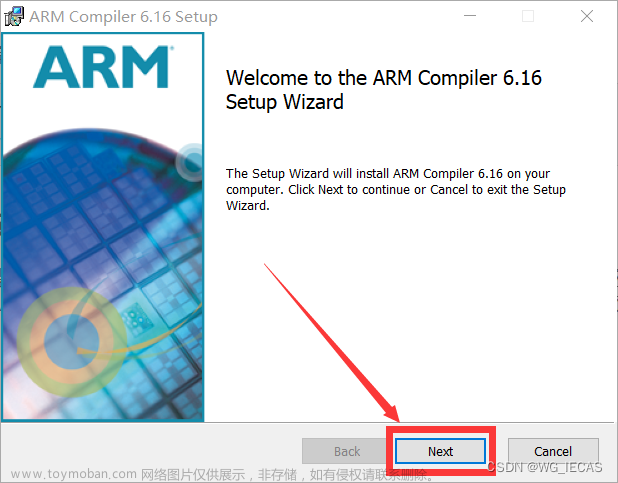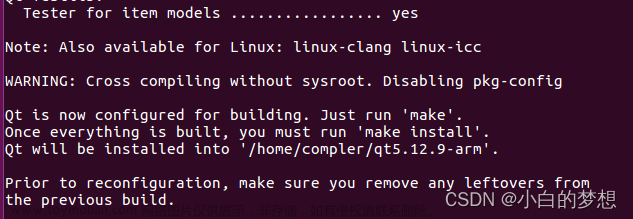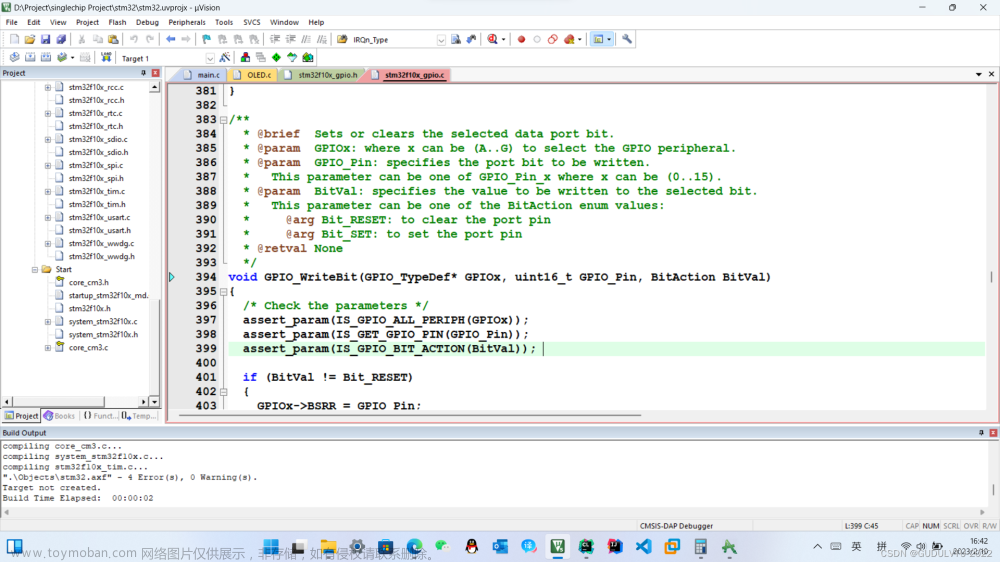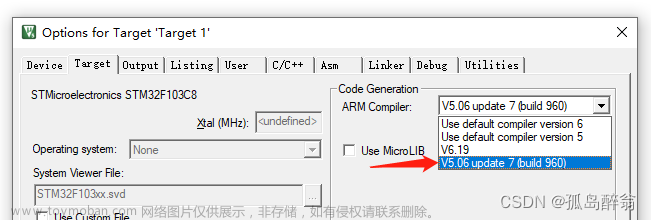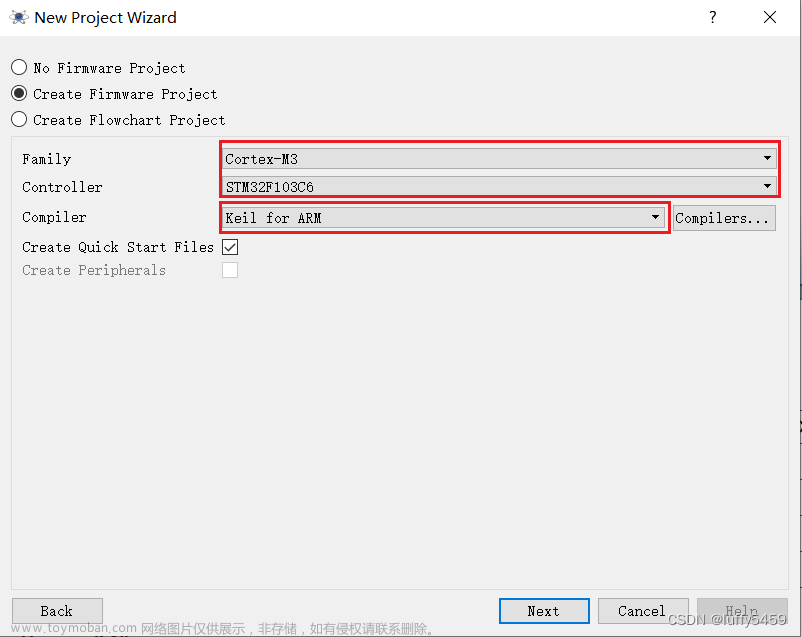目录
1, Introduction to Arm® Compiler 6
1.1 armclang
1.2 armasm
1.3 armlink
1.4 armar
1.5 fromelf
1.6 Arm C++ libraries
1.7 Arm C libraries
1,8 Application development ,ARM程序开发流程
2,ARM 编译器 5和ARM 编译器 6的兼容性
3,ARM编译器相关链接
1, Introduction to Arm® Compiler 6
Arm Compiler 6 是 Arm 中用于 Arm Cortex® 和 Arm Neoverse™ 处理器的最先进的 C 和 C++ 编译工具链。Arm Compiler 6 与 Arm 架构一起开发。因此,Arm 编译器 6 经过优化,可为从小型传感器到 64 位设备的嵌入式裸机应用生成高效代码。
Arm Compiler 6 将 Arm 优化的工具和库与基于 LLVM 的现代编译器框架相结合。Arm 编译器 6 中的组件包括:
- armclang
- armasm
- armlink
- armar
- Arm C++ libraries
- Arm C libraries
1.1 armclang
编译 C、C++ 和 GNU 汇编语言源的编译器和汇编编译器。基于LLVM和Clang技术。Clang是LLVM的编译器前端,可以支持C和C++等编程语言。
1.2 armasm
传统的汇编编译器,针对ARM语法的汇编代码。使用armclang是针对GNU 语法的汇编文件。
1.3 armlink
armlink链接器可以将一个或多个目标文件以及一个或多个目标程序库链接,生成一个可执行的程序。
1.4 armar
归档器(archiver)可以将 多个ELF 对象收集在一起,并在归档或库中进行维护。如果不经常更改这些文件,这些已经编译好的ELF文件可以减少编译时间,因为不必每次使用它们时都从源代码重新编译。并且可以将此类库或存档传递给链接器,以代替多个 ELF 。还可以使用存档分发给第三方应用开发人员,这样就可以在不泄露源代码的情况下共享存档。
1.5 fromelf
fromelf可以将 Arm ELF 文件转换为二进制格式。它还可以生成有关输入的elf文件的文本信息,例如其反汇编、代码大小和数据大小。
1.6 Arm C++ libraries
Arm C++库是基于LLVM libc++工程:
- libc++abi 库是一个rubtime 库,提供大量的低级语言特性的实现。
- libc++ 库同样提供 ISO C++的标准库实现
如果C++编译单元是用不同的主要或次要版本的Arm编译器编译的,并且链接到单个image。那么ARM不保证该c++编译单元的兼容性。因此,ARM建议在编译C++源码时,使用单一版本的工具链。此外也支持C和C++的混合编译。
1.7 Arm C libraries
ARM的C库提供:
- 标准的C语言库特性的实现。
- 许多非标准的通用的C语言扩展
- POSIX 扩展功能。
- 使用POSIX的函数标准化。
1,8 Application development ,ARM程序开发流程
一个典型的ARM程序开发流程应该包含:
- 为主程序开发C/C++源码 (armclang)。
- 为底层硬件组件开发汇编源码,比如中断服务子程序(armclang,或者针对arm 汇编代码的armasm)
- 将所有目标文件链接成一个elf image(armlink)
- 将一个image转换成 plain binary, Intel Hex, 或者Motorola-Smeld等格式。
下图展示了一个典型的应用程序开发流程:



需要注意的是,
2,ARM 编译器 5和ARM 编译器 6的兼容性
如果用户之前使用的是ARM compiler 5,需要将code在ARM compiler 6中编译,可以参考文档:
Arm Compiler for Embedded Migration and Compatibility Guide
compiler 5和compiler6最大的区别在于compiler 5使用的是armcc,而compiler 6使用的是armclang。以下是二者工具链的对比表格:
| Arm Compiler 5 | Arm Compiler for Embedded 6 | Function |
|---|---|---|
armcc |
armclang |
Compiles C and C++ language source files, including inline assembly. |
armcc |
armclang |
Preprocessor. |
armasm |
armasm |
Legacy assembler for assembly language source files written in armasm syntax. Use the armclang integrated assembler for all new assembly files. |
| Not available |
armclang. This is also called the armclang integrated assembler. |
Assembles assembly language source files written in GNU assembly syntax. |
fromelf |
fromelf |
Converts Arm ELF images to binary formats and can also generate textual information about the input image, such as its disassembly and its code and data size. |
armlink |
armlink |
Combines the contents of one or more object files with selected parts of one or more object libraries to produce an executable program. |
armar |
armar |
Enables sets of ELF object files to be collected together and maintained in archives or libraries. |
3,Compiler 6所支持的ARM 架构
Arm Compiler for Embedded 6支持以下ARM架构:
- Armv9-A.
- Armv8-A and all update releases, for bare-metal targets.
- Armv8-R.
- Armv8-M.
- Armv7-A for bare-metal targets.
- Armv7-R.
- Armv7-M.
- Armv6-M.
当编译代码时,编译器需要知道以哪种体系结构为目标,以便利用特定于该体系结构的特性。要指定目标架构,必须提供目标执行状态(AArch32或AArch64),以及目标体系结构(例如Armv8-A)或目标处理器(例如cortex-A53处理器)。
要使用armclang指定目标执行状态(AArch64或AArch32),使用强制的 --target 命令行选项:
--target=<arch>-<vendor>-<os>-<abi>
支持的目标包括:
- aarch64-arm-none-eabi
- 为A64状态产生A64的指令,如果没有指定-march 或者-mcpu 属性,则暗示-march=armv8-a
- arm-arm-none-eabi
- 为A32状态产生A32的指令,同时必须使用-march(指定架构) 和-mcpu(指定处理器)
如果想要针对某个架构的所有处理器生成通用的代码,可以使用-march 选项,使用 -march=list
可以看到全部的支持的架构。此外,如果想针对某款处理器优化你的代码,可以使用 -mcpu 选项,使用 -mcpu=list 可以看到全部的支持的处理器。文章来源:https://www.toymoban.com/news/detail-411665.html
需要注意的是,--target, -march和-mcpu选项是armclang选项。对于所有其他工具,如armlink,使用 --cpu选项指定目标处理器和体系结构。文章来源地址https://www.toymoban.com/news/detail-411665.html
4,ARM编译器相关链接
| Arm product resources | Document ID | Confidentiality |
|---|---|---|
| Arm Compiler for Embedded Reference Guide | 101754 | Non-Confidential |
| Arm Compiler for Embedded Migration and Compatibility Guide | 100068 | Non-Confidential |
| Arm Compiler for Embedded Arm C and C++ Libraries and Floating-Point Support User Guide | 100073 | Non-Confidential |
| Arm Compiler for Embedded Errors and Warnings Reference Guide | 100074 | Non-Confidential |
| Arm Support | - | - |
| Arm Compiler for Linux | - | - |
| Arm Development Studio Getting Started Guide | 101469 | Non-Confidential |
| Arm Development Studio User Guide | 101470 | Non-Confidential |
| Arm Compiler for Embedded Licensing Configuration | - | - |
| Request a license | - | - |
| Manage Arm Compiler Versions | - | Non-Confidential |
| User-based licensing User Guide | 102516 | Non-Confidential |
| CMSIS 5 | - | Non-Confidential |
| Arm® architecture and specifications | Document ID | Confidentiality |
|---|---|---|
| Arm Architecture Reference Manual for A-profile architecture | DDI 0487 | Non-Confidential |
| ARM Architecture Reference Manual ARMv7-A and ARMv7-R edition | DDI 0406 | Non-Confidential |
| A-Profile Architecture | - | Non-Confidential |
| M-Profile Architecture | - | Non-Confidential |
| R-Profile Architecture | - | Non-Confidential |
| ABI for the Arm Architecture | - | Non-Confidential |
| Base Platform ABI for the Arm Architecture | - | Non-Confidential |
| C Library ABI for the Arm Architecture | - | Non-Confidential |
| C++ ABI for the Arm Architecture | - | Non-Confidential |
| C++ Application Binary Interface Standard for the Arm 64-bit Architecture | - | Non-Confidential |
| DWARF for the Arm Architecture | - | Non-Confidential |
| ELF for the Arm Architecture | - | Non-Confidential |
| Exception Handling ABI for the Arm Architecture | - | Non-Confidential |
| Procedure Call Standard for the Arm Architecture | - | Non-Confidential |
| Run-time ABI for the Arm Architecture | - | Non-Confidential |
| Support for Debugging Overlaid Programs | - | Non-Confidential |
| Addenda to, and Errata in, the ABI for the Arm Architecture | - | Non-Confidential |
| Whitepaper - Armv8-M Architecture Technical Overview | - | Non-Confidential |
| Armv8-M Stack Sealing vulnerability | - | Non-Confidential |
| Non-Arm resources | Document ID | Organization |
|---|---|---|
| GCC | - | Top (Using the GNU Compiler Collection (GCC)) |
| GNU Binutils | - | https://sourceware.org/binutils |
| Itanium C++ ABI | - | C++ ABI Summary |
| The Security Implications Of Compiler Optimizations On Cryptography - A Review | - | https://arxiv.org |
| Using Clang as a Compiler | - | Welcome to Clang's documentation! — Clang 17.0.0git documentation |
| Automatic variable initialization | - | https://reviews.llvm.org |
| C++ implementation status in LLVM Clang | - | Welcome to Clang's documentation! — Clang 17.0.0git documentation |
| Undefined Behavior Sanitizer | - | Welcome to Clang's documentation! — Clang 17.0.0git documentation |
| Update for Universal C Runtime in Windows | - | https://support.microsoft.com |
到了这里,关于ARM 编译器 Arm Compiler for Embedded 6 相关工具链简介的文章就介绍完了。如果您还想了解更多内容,请在右上角搜索TOY模板网以前的文章或继续浏览下面的相关文章,希望大家以后多多支持TOY模板网!

